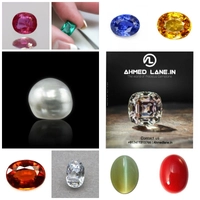Emerald (Panna)
Emerald
The bright green gem of the beryl mineral family and May birthstone.
Author: Hobart M. King, PhD, GIA Graduate Gemologist
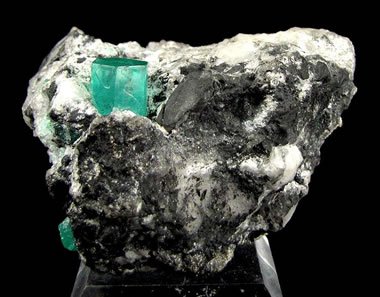
Emeralds from Colombia: Emerald crystals in a calcite and graphitic shale matrix from the Coscuez Mine, near Muzo, northwestern Colombia. The well-formed crystal with an attractive bluish-green color is about 1.1 centimeters tall. Specimen and photo by Arkenstone / www.iRocks.com.
ADVERTISEMENT
What Are Emeralds?
Emeralds are gem-quality specimens of the beryl mineral family with a rich, distinctly green color. They are found in igneous, metamorphic, and sedimentary rocks in a small number of locations worldwide.
For over 5000 years, emeralds have been one of the most desirable and valuable colored stones. Ancient civilizations in Africa, Asia, and South America independently discovered emeralds and made them a gemstone of highest esteem. In the United States and many other countries, emerald serves as the birthstone for people who were born in the month of May.
Today emerald, together with ruby and sapphire, form the "big three" of colored stones. The "big three" generate more economic activity than all other colored stones combined. In 2015 the value of emeralds imported into the United States exceeded the value of all colored stones outside of the "big three" combined.
Table of Contents
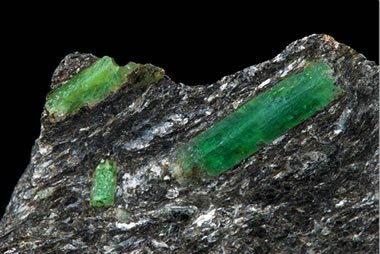
Emeralds from Russia: Photograph of emerald crystals in mica schist from the Malyshevskoye Mine, Sverdlovsk Region, Southern Ural, Russia. The large crystal is about 21 millimeters in length. Photograph copyright iStockphoto / Epitavi.
Physical Properties of Emerald | |
| Color | A distinctly green color that ranges between bluish green and slightly yellowish green. Stones with a light tone or a low saturation should be called "green beryl" instead of emerald. |
| Clarity | Almost every natural emerald has eye-visible characteristics that can be inclusions, surface-reaching fractures, or healed fractures. Treatments to fill the fractures with oils, waxes, polymers, flux and other materials to reduce their visibility has been common practice for hundreds of years. |
| Luster | Vitreous |
| Diaphaneity | Transparent to translucent |
| Cleavage | One direction of imperfect cleavage |
| Durability | Emerald is very hard, but almost all specimens have inclusions and surface-reaching fractures that compromise their durability. |
| Mohs Hardness | 7.5 to 8 |
| Specific Gravity | 2.7 to 2.8 |
| Chemical Composition | Be3Al2(SiO3)6 Emerald's green color is caused by trace amounts of chromium or vanadium. |
| Crystal System | Hexagonal. Often as prismatic crystals. |
Emerald's Green Color
Beryl, the mineral of which emerald is a variety, has a chemical composition of Be3Al2(SiO3)6. When pure, beryl is colorless and known as "goshenite." Trace amounts of chromium or vanadium in the mineral cause it to develop a green color. Trace amounts of iron will tint emerald a bluish green or a yellowish green color depending upon its oxidation state.
ADVERTISEMENT
Emerald is defined by its green color. To be an emerald, a specimen must have a distinctly green color that falls in the range from bluish green to green to slightly yellowish green. To be an emerald, the specimen must also have a rich color. Stones with weak saturation or light tone should be called "green beryl." If the beryl's color is greenish blue then it is an "aquamarine." If it is greenish yellow it is "heliodor."
This color definition is a source of confusion. Which hue, tone, and saturation combinations are the dividing lines between "green beryl" and "emerald"? Professionals in the gem and jewelry trade can disagree on where the lines should be drawn. Some believe that the name "emerald" should be used when chromium is the cause of the green color, and that stones colored by vanadium should be called "green beryl."
Calling a gem an "emerald" instead of a "green beryl" can have a significant impact upon its price and marketability. This "color confusion" exists within the United States. In some other countries, any beryl with a green color - no matter how faint - is called an "emerald."
Be careful if you are buying an "emerald". Make sure that you are getting a gem that has a rich green color instead of a "green beryl". Buying from a website where people from outside of the United States are acting as third-party sellers and photographs might not have representative color can be especially risky.
ADVERTISEMENT
The Name "Yellow Emerald" Is Incorrect
By definition, emeralds are gem-quality specimens of the beryl mineral family with a rich, distinctly green color. Because of that, it is inappropriate to use the name "emerald" when marketing a beryl of any other color.
The Federal Trade Commission publishes a set of Guides for the Jewelry, Precious Metals and Pewter Industries. They use "yellow emerald" as an example of an incorrect name that when used in marketing can be "unfair", "misleading" and "deceptive" (the words here in quotes are straight from FTC guidance for jewelers). More information here.
If you are going to buy a "yellow emerald" it might be a good idea to compare it with an equivalent material that is properly marketed as heliodor or yellow beryl. Heliodor is a beautiful gem. It sells for a lot less than emerald and it usually does not suffer from the durability and clarity problems that are common in emeralds.
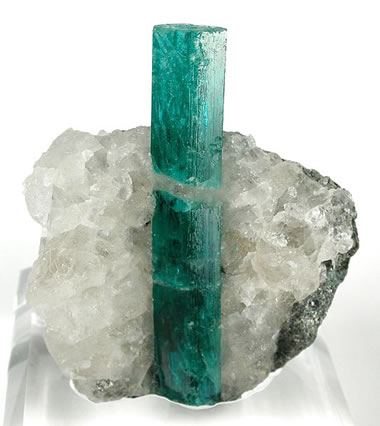
Emerald from Zambia: Emerald crystal from the Kagem Emerald Mine, Zambia, on a matrix of quartz and mica schist. This specimen is about 6.5 centimeters in height and has the blue-green color and medium dark tone that is common in many emeralds mined in Zambia. Specimen and photo by Arkenstone / www.iRocks.com.
ADVERTISEMENT
Clarity, Treatments, and Durability
Emerald has a Mohs hardness of 7.5 to 8, which is normally a very good hardness for jewelry use. However, most emeralds contain numerous inclusions or surface-reaching fractures. These can weaken the gem, cause it to be brittle, and make it subject to breakage.
These are expected characteristics of emerald. It is rare to find an emerald that does not have inclusions and surface-reaching fractures that can be seen with the unaided eye. Under low magnification, most emeralds are said to have a "garden" of inclusions.
To improve appearance, most cut emeralds are treated with oils, waxes, polymers, or other substances that enter the fractures and make them less obvious. Although these treatments might improve appearance, they often do not improve the durability of the gem and they may discolor or deteriorate over time.
With that information, emerald should be considered a fragile stone that is best worn as a ring stone on special occasions rather than daily. Emerald is better suited for earrings and pendants that are usually subjected to less impact and abrasion than rings and bracelets. Settings that protect the stone are much safer than those that present the stone to impact and abrasion.
Cleaning emeralds should be done carefully. Steam and ultrasonic cleaning can remove oils and other fracture-filling treatments. A light washing in warm water with a mild soap is safer for cleaning and should be done only when needed.
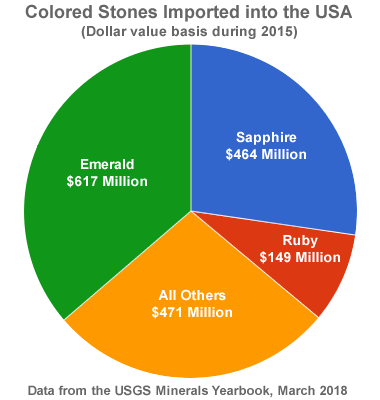
Emerald imports: This graph illustrates the popularity of emeralds in the United States. The pie represents all colored stones imported into the United States during 2015 on the basis of dollar value. As a single gem variety, emerald holds the biggest share of the pie. More dollars' worth of emeralds were imported than any other colored stone. More dollars' worth of emeralds were imported than ruby and sapphire combined. Data from the USGS Minerals Yearbook, March 2018. [1]
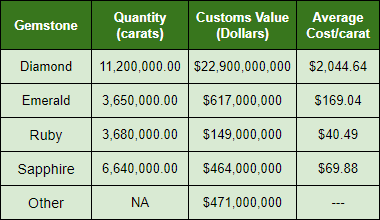
Gemstone import value: This chart shows the quantity and value of diamond, emerald, ruby, sapphire, and other colored stones imported into the United States during 2015. This chart shows that, on the basis of cut but unset value, emerald is the most important gemstone import for the United States after diamond. It also has an average per-carat price that is much higher than ruby and sapphire. These amounts are approximately equal to consumption because the amount of domestic production was just several million dollars total. Data from the USGS Minerals Yearbook, March 2018. [1]
Geologic and Geographic Occurrence
Beryl is a rare mineral with a chemical composition of Be3Al2(SiO3)6. It is rare because beryllium is an element that occurs in very small amounts in the Earth’s crust. It is unusual for enough beryllium to be present in one location to form minerals. In addition, the conditions in which beryllium is present in significant amounts are different from the conditions where chromium and vanadium, the sources of emerald’s green color, are expected. This is why emerald is rare and only found in a small number of locations.
Today, most emerald production originates in four source countries: Colombia, Zambia, Brazil, Ethiopia, and Zimbabwe. These countries reliably produce commercial amounts of emeralds. Minor amounts of production or irregular production comes from Madagascar, Nigeria, Afghanistan, Pakistan, Canada, Russia, and a few other countries.
Starting in about 2015, significant amounts of emerald with exceptional color and clarity started to be exported from Ethiopia. An editorial on the JCK website speculated that these Ethiopian emeralds might be the greatest gem find in 100 years. [2] An article in Gems & Gemology surveys the production of emerald in Ethiopia through 2017. [11]
Even though the conditions for the formation of emerald are very unlikely, the gem has been found in a diversity of rock types. In Colombia, the country that has supplied most of the world’s emeralds, black organic shale and carbonaceous limestone, both sedimentary rocks, are the ores for many emerald deposits. The shale is thought to be the source of chromium, and the beryllium is thought to have been delivered by ascending fluids.
Many of the world's emerald deposits have formed in areas of contact metamorphism. A granitic magma can serve as a source of beryllium, and nearby carbonaceous schist or gneiss can serve as a source of chromium or vanadium. These emeralds usually form in schist or gneiss or in the margins of a nearby pegmatite. Mafic and ultramafic rocks can also serve as sources for chromium or vanadium.
Emeralds are rarely mined from alluvial deposits. Emerald is usually a fractured stone that does not have the alluvial durability to persist great distances from its source. Emerald also has a specific gravity of 2.7 to 2.8, which is not significantly different from quartz, feldspar, and other common materials found in stream sediments. It therefore does not concentrate with high-density grains which are segregated in the stream and more easily recovered by placer mining.
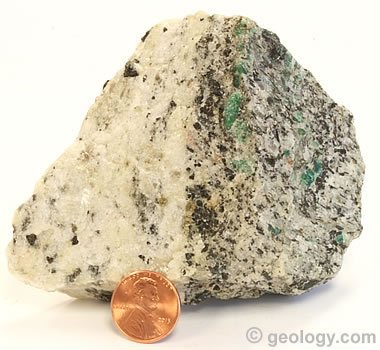
Emerald from North Carolina: A specimen of the Crabtree Pegmatite of western North Carolina. This granitic pegmatite filled a two-meter-wide fracture which contained emerald along the walls of the fracture and yellow beryl in the center. It was mined for emeralds by Tiffany and Company and a series of property owners between 1894 and the 1990s. Many fine clear emeralds were produced, but most of the emerald-bearing rock was sold as "emerald matrix" for slabbing and cabochon cutting. The cabochons displayed emerald and tourmaline prisms in a white matrix of quartz and feldspar. This specimen is about 7 x 7 x 7 centimeters in size and contains numerous small emerald crystals that are up to several millimeters in length and associated with schorl.
Emerald Mining in the United States
Very few emeralds have been mined in the United States. North Carolina has been a sporadic producer of emeralds in small quantities from a few tiny mines since the late 1800s. The Crabtree Emerald Mine was once operated by Tiffany and Company and a series of property owners between 1894 and the 1990s. Many fine clear emeralds were produced, and tons of emerald-bearing pegmatite were sold as "emerald matrix" for slabbing and cabochon cutting. The cabochons displayed emerald and tourmaline prisms in a white matrix of quartz and feldspar. A specimen of the Crabtree Pegmatite is shown on this page.
North American Emerald Mines operates a small mine near Hiddenite, North Carolina. Between 1995 and 2010, over 20,000 carats of emeralds were produced, including a six-inch-long, 1,869-carat crystal that is now in the Houston Museum of Natural Science and valued at $3.5 million. A crushed stone quarry on the same property is operated with employees watching for signs of the hydrothermal veins and pockets that sometimes contain emerald. It is one of the only gemstone mines in the world that sells the country rock. [3]
Credit:www.geology.com
